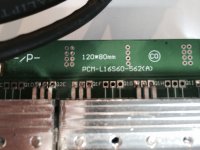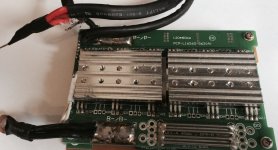gone_walkabouts
100 mW
Hi all,
I have a Chinese Cheapo BMS attached to a 48v headway pack. The battery performs reasonable well until around 200 cycles. When I open the pack two cell were dead and the other cell where out of balance by up to 0.5 v
Related to this I have moved into the LIPO battery work were balancing is important and much more widely discussed.
The question I have is what would be stopping my Headway LiFePO4 pack from getting out of balance. I assume nothing even with a BMS.
the way I think my cheap BMS works http://www.bmsbattery.com/bmspcm/323-17s26s-24a-max-discharge-current-bms.html
is when the Pack is charging, once the first cell in the pack goes up through the 3.9v mark it cut the main chargers cuts out. Some cells can be still at 3.5v etc......where is the balancing in that.
I don't see any balancing going on here and wonder if it is
1)a limitation of the BMS
2) the BMS has a fault
3) I just have too high expectations !!
The BMS might be faulty as it has seemingly eaten (completely flattened) the first headway cell or last cell in the series (cannot remember which) a few times now. Yes It has killed 3 headway cells so I assume it is the BMS not the cells at fault.
If any one could be so kind as to correct my thoughts or share their thoughts that would be very much appreciated. Particular interest in how balancing should work on a BMS. My cells just seem to race away once the go past 3.7v and the BMS does not seem to have a chance to pull them back. The majority of cells are left behind and do not get a full charge. This can cause issues on the discharge cycle where again the BMS does not seem to be cut the pack when a cell is dead ! !!
Cheers
I have a Chinese Cheapo BMS attached to a 48v headway pack. The battery performs reasonable well until around 200 cycles. When I open the pack two cell were dead and the other cell where out of balance by up to 0.5 v
Related to this I have moved into the LIPO battery work were balancing is important and much more widely discussed.
The question I have is what would be stopping my Headway LiFePO4 pack from getting out of balance. I assume nothing even with a BMS.
the way I think my cheap BMS works http://www.bmsbattery.com/bmspcm/323-17s26s-24a-max-discharge-current-bms.html
is when the Pack is charging, once the first cell in the pack goes up through the 3.9v mark it cut the main chargers cuts out. Some cells can be still at 3.5v etc......where is the balancing in that.
I don't see any balancing going on here and wonder if it is
1)a limitation of the BMS
2) the BMS has a fault
3) I just have too high expectations !!
The BMS might be faulty as it has seemingly eaten (completely flattened) the first headway cell or last cell in the series (cannot remember which) a few times now. Yes It has killed 3 headway cells so I assume it is the BMS not the cells at fault.
If any one could be so kind as to correct my thoughts or share their thoughts that would be very much appreciated. Particular interest in how balancing should work on a BMS. My cells just seem to race away once the go past 3.7v and the BMS does not seem to have a chance to pull them back. The majority of cells are left behind and do not get a full charge. This can cause issues on the discharge cycle where again the BMS does not seem to be cut the pack when a cell is dead ! !!
Cheers



